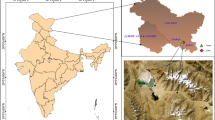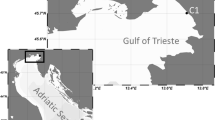Abstract
Spatiotemporal variations in microbial gene abundances were investigated to identify potential zones of methanotroph and methanogen biomass in a peat bog in Sarobetsu-genya wetland. The abundances of the bacterial and archaeal 16S rRNA genes, pmoA, and mcrA were 107–109, 107–108, 104–106, and 104–107 copies g−1 dry peat, respectively. Correlation analysis based on microbial gene abundances and environmental factors showed that the spatiotemporal distributions of the abundances of the four microbial genes in peat layers were similar. The mcrA abundance showed a significant negative correlation with the dissolved organic carbon content and a significant positive correlation with the peat temperature. The pmoA abundance was not detectable during the spring thaw when the lowest peat temperature at a depth of 50 cm was recorded. At a depth of 200 cm, the peat temperature exceeded 6°C throughout the year, and the mcrA abundance exceeded 104 copies g−1 dry peat. These results indicate that the seasonal microbial activity related to methane should be evaluated in not only the shallow but also the deep peat layers in order to elucidate the methane dynamics in boreal wetlands.




Similar content being viewed by others
References
Basiliko N, Yavitt JB, Dees PM, Merkel SM (2003) Methane biogeochemistry and methanogen communities in two northern peatland ecosystems, New York State. Geomicrobiol J 20:563–577
Berestovskaya YY, Vasil’eva LV, Chestnykh OV, Zavarzin GA (2002) Methanotrophs of the psychrophilic microbial community of the Russian arctic tundra. Microbiology 71:460–466
Bernard PS, Wittwer CT (2002) Real-time PCR technology for cancer diagnostics. Clin Chem 48:1178–1185
Cadillo-Quiroz H, Bräuer S, Yashiro E, Sun C, Yavitt J, Zinder S (2006) Vertical profiles of methanogenesis and methanogens in two contrasting acidic peatlands in central New York State, USA. Environ Microbiol 8:1428–1440
Conrad R (1996) Soil microorganisms as controllers of atmospheric traces gases (H2, CO, CH4, OCS, N2O, and NO). Microbiol Rev 60:609–640
Costello AM, Lidstrom ME (1999) Molecular characterization of functional and phylogenetic genes from natural populations of methanotrophs in lake sediments. Appl Environ Microbiol 65:5066–5074
Dedysh SN, Liesack W, Khmelenina VN, Suzina NE, Trotsenko YA, Semrau JD, Abing AM, Panikov NS, Tiedje JM (2000) Methylocella palustris gen. nov., sp. nov., a new methane-oxidizing acidophilic bacterium from peat bogs, representing a novel subtype of serine-pathway methanotrophs. Int J Syst Evol Microbiol 50:955–969
Dedysh SN, Berestovskaya YY, Vasylieva LV, Belova SE, Khmelenina VN, Suzina NE, Trotsenko YA, Liesack W, Zavarzin GA (2004) Methylocella tundrae sp. Nov., a novel methanotrophic bacterium from acidic tundra peatlands. Int J Syst Evol Microbiol 54:151–156
DeJournett TD, Arnold WA, Lapara TM (2007) The characterization and quantification of methanotrophic bacterial populations in constructed wetland sediments using PCR targeting 16S rRNA gene fragments. Appl Soil Ecol 35:648–659
DeLong EF (1992) Archaea in coastal marine environments. Proc Natl Acad Sci USA 89:5685–5689
Dise N (1992) Winter fluxes of methane from Minnesota peatlands. Biogeochemistry 17:71–83
Dunfield P, Knowles R, Dumont R, Moore TR (1993) Methane production and consumption in temperate and subarctic peat soils: response to temperature and pH. Soil Biol Biochem 25:321–326
Edwards C, Hales BA, Hall GH, McDonald IR, Murrell JC, Pickup R, Ritchie DA, Saunders JR, Simon BM, Upton M (1998) Microbiological processes in the terrestrial carbon cycle: methane cycling in peat. Atmos Environ 32:3247–3255
Ferris MJ, Muyzer G, Ward DM (1996) Denaturing gradient gel electrophoresis profiles of 16S rRNA-defined populations inhabiting a hot spring microbial mat community. Appl Environ Microbiol 62:340–346
Ferry JG (1992) Biochemistry of methanogenesis. Crit Rev Biochem Mol Biol 27:473–503
Ferry JG (1999) Enzymology of one-carbon metabolism in methanogenic pathways. FEMS Microbiol Rev 23:13–38
Fujita H (1997) The process of extinction of Sarobetsu Mire, northern Hokkaido. In: Tsujii T, Tachibana H, Shinsho H, Uemura S, Yabe K, Fujita H (eds) Vegetation and recent changes of mire areas in Hokkaido—the conservation of mires in Hokkaido, Report of The Pro Nature Foundation (Japan) Fiscal years of 1994/1995 (in Japanese). The Pro Nature Foundation, Tokyo, pp 59–71
Galand PE, Saarnio S, Fritze H, Yrjälä K (2002) Depth related diversity of methanogen Archaea in Finnish oligotrophic fen. FEMS Microbiol Ecol 42:441–449
Hales BA, Edwards C, Ritchie DA, Hall G, Pickup RW, Saunders JR (1996) Isolation and identification of methanogen-specific DNA from blanket bog peat by PCR amplification and sequence analysis. Appl Environ Microbiol 62:668–675
Hargreaves KJ, Fowler D, Pitcairn CER, Aurela M (2001) Annual methane emission from Finnish mires estimated from eddy covariance campaign measurements. Theor Appl Climatol 70:203–213
Henckel T, Jäckel U, Schenell S, Conrad R (2000) Molecular analysis of novel methanotrophic communities in forest soil that oxidize atmospheric methane. Appl Environ Microbiol 66:1801–1808
Holmes AJ, Costello A, Lidstrom ME, Murrell JC (1995) Evidence that particulate methane monooxygenase and ammonia monooxygenase may be evolutionarily related. FEMS Microbiol Lett 132:203–208
Inagaki F, Tsunogai U, Suzuki M, Kosaka A, Machiyama H, Takai K, Nunoura T, Nealson KH, Horikoshi K (2004) Characterization of C1-metabolizing prokaryotic communities in methane seep habitats at the Kuroshima Knoll, southern Ryukyu arc, by analyzing pmoA, mmoX, mxaF, mcrA, and 16S rRNA genes. Appl Environ Microbiol 70:7445–7455
Juottonen H, Galand PE, Tuittila ES, Laine J, Fritze H, Yrjäjä K (2005) Methanogen communities and bacteria along and ecohydrological gradient in a northern raised bog complex. Environ Microbiol 7:1547–1557
Juottonen H, Tuittila E-S, Juutinen S, Fritze H, Yrjälä K (2008) Seasonality of rDNA- and rRNA-derived archaeal communities and methanogenic potential in a boreal mire. ISME J 2:1157–1168
Lane DJ (1991) 16S/23S rRNA sequencing. In: Stackebrandt E, Goodfellow M (eds) Nucleic acid techniques in bacterial systematics. Wiley, New York, pp 115–148
Luu-The V, Paquet N, Calvo E, Cumps J (2005) Improved real-time RT-PCR method for high-throughput measurements using second derivative calculation and double correction. BioTechniques 38:287–293
McDonald IR, Upton M, Hall G, Pickup RW, Edwards C, Saunders JR, Ritchie DA, Murrell JC (1999) Molecular ecological analysis of methanogens and methanotrophs in blanket bog peat. Microb Ecol 38:225–233
Mitsch WJ, Gosselink JG (2007) Wetlands, 4th edn. Wiley, New York
Murrell JC, Gilbert B, McDonald IR (2000) Molecular biology and regulation of methane monooxygenase. Arch Microbiol 173:325–332
Nozhevnikova AN, Zepp K, Vazquez F, Zehnder AJB, Holliger C (2003) Evidence for the existence of psychrophilic methanogenic communities in anoxic sediments of deep lakes. Appl Environ Microbiol 69:1832–1835
Ohira A (1995) Holocene evolution of peatland and paleoenvironmental changes in the Sarobetsu Lowland, Hokkaido, Northern Japan (in Japanese). Geogr Rev Jpn 68A:695–712
Reddy KR, DeLaune RD (2008) Biogeochemistry of wetlands: science and applications. CRC, Taylor & Francis, Boca Raton
Reeve JN, Nolling J, Morgan RM, Smith DR (1997) Methanogenesis: genes, genomes, and who’s on first? J Bacteriol 179:5975–5986
Sizova MV, Panikov NS, Tourova TP, Flanagan PW (2003) Isolation and characterization of oligotrophic acido-tolerant methanogenic consortia from a Sphagnum peat bog. FEMS Microbiol Ecol 45:301–315
Svensson BH (1984) Different temperature optima for methane formation when enrichments from acid peat are supplemented with acetate or hydrogen. Appl Environ Microbiol 48:389–394
Thauer RK (1998) Biochemistry of methanogenesis: a tribute to Marjory Stephenson. 1998 Marjory Stephenson Prize Lecture. Microbiology 144:2377–2406
Theisen AR, Murrell JC (2005) Facultative methanotrophs revisited. J Bacteriol 187:4303–4305
Tokida T, Mizoguchi M, Miyazaki T, Kagemoto A, Nagata O, Hatano R (2007) Episodic release of methane bubbles from peatland during spring thaw. Chemosphere 70:165–171
Wahlen M (1993) The global methane cycle. Ann Rev Earth Planet Sci 21:407–426
Wang Z, Zeng D, Patrick WH Jr (1996) Methane emission from natural wetlands. Environ Monit Assess 42:143–161
Weisberg WG, Barns SM, Pelletier DA, Lane DJ (1991) 16S ribosomal DNA amplification for phylogenetic study. J Bacteriol 173:697–703
Wilms R, Sass H, Kopke B, Cypionka H, Engelen B (2007) Methane and sulfate profiles within the subsurface of a tidal flat are reflected by the distribution of sulfate-reducing bacteria and methanogenic Archaea. FEMS Microbiol Ecol 59:611–621
Zeikus JG, Winfrey MR (1976) Temperature limitation of methanogenesis in aquatic sediments. Appl Environ Microbiol 31:99–107
Zhang G, Tian J, Jiang N, Guo X, Wang Y, Dong X (2008) Methanogen community in Zoige wetland of Tibetan plateau and phenotypic characterization of a dominant uncultured methanogen cluster ZC-I. Envinron Microbiol 10:1850–1860
Acknowledgments
This work was supported by the Ministry of Economy, Trade and Industry (METI) of Japan.
Author information
Authors and Affiliations
Corresponding author
Rights and permissions
About this article
Cite this article
Akiyama, M., Shimizu, S., Sakai, T. et al. Spatiotemporal variations in the abundances of the prokaryotic rRNA genes, pmoA, and mcrA in the deep layers of a peat bog in Sarobetsu-genya wetland, Japan. Limnology 12, 1–9 (2011). https://doi.org/10.1007/s10201-010-0315-3
Received:
Accepted:
Published:
Issue Date:
DOI: https://doi.org/10.1007/s10201-010-0315-3




